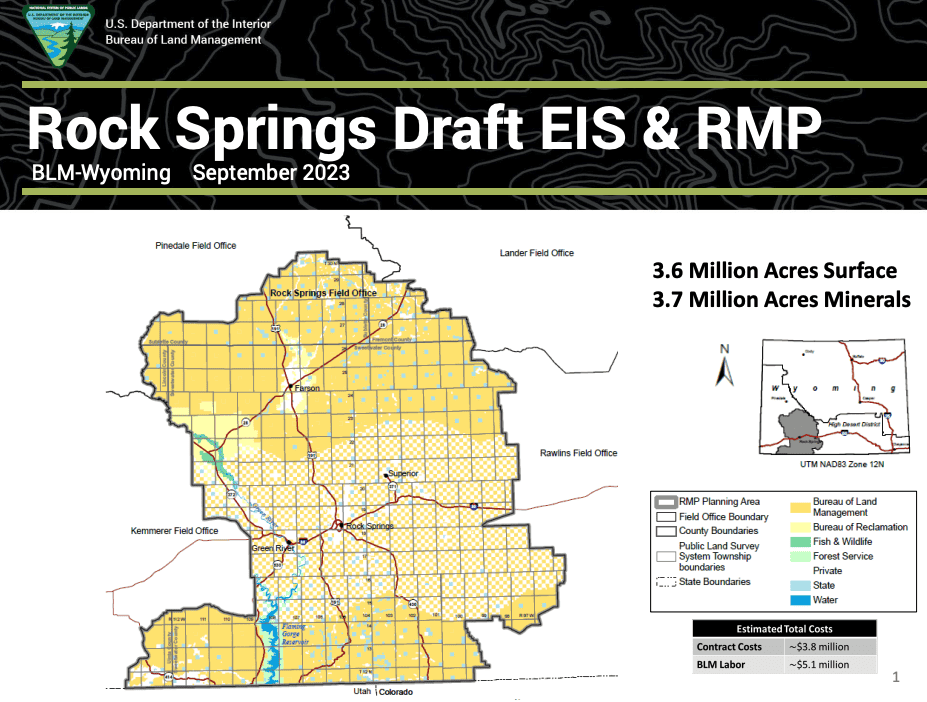The Rock Springs (WY) office of the BLM has recently released a draft of its resource management plan. The DEIS includes the traditional four alternatives: no-change, protection, development, and “balanced.” As Governor Gordon’s natural resources policy advisor put it, “In this case they kind of broke precedent and chose (alternative) B, the most resource-restrictive development.” A retired BLM employee has alleged that presidential politics played a role.
The most balanced plan for managing millions of acres of federal land in central Wyoming — and the alternative that Bureau of Land Management employees and others put the most time, effort and money into — was rejected by the past two presidential administrations, a retired BLM employee said.
The Trump administration likely would have pushed Alternative C because it favors more drilling for oil, he said.
But the Biden administration has gone to the opposite extreme, so the BLM now is pushing forward with Alternative B, which designates 1.8 million acres as “areas of critical environmental concern” (ACES).
Evans said it’s disheartening that two presidential administrations boosted the plans with the least amount of effort put into them.
“The science and the work to do that was all done on D,” Evans said. “And it’s kind of a shame that what the people in the field office and the cooperators spent all that time doing was rejected.”
Now many of those same BLM insiders who worked for years and spent millions of dollars fleshing out a balanced alternative instead have to push the administration’s preference and sell it to Wyoming residents and officials.
The State of Wyoming is considering suing over the plan (even though is not final yet). Road management and minerals are key issues.

The exact same thing happened with the Labyrinth Rims Gemini Bridges travel management plan in Utah. Everyone expected the BLM would choose the alternative characterized as balanced (though in truth there is no such thing in a travel plan, as every alternative is just varying degrees of closures). But instead the BLM choose only a slightly scaled back version of the most extreme alternative, closing over 300 miles of literally the most valuable motorized trails in the country. I can only assume this decision came straight from Tracy Stone Manning because I doubt the local field office would have been that stupid. Yet now they’re stuck with the task of selling the closure of world famous trails that have been featured in published guidebooks for decades as a good thing.
Lawsuits are being filed to challenge this, and Senator Mike Lee has already introduced a bill in the Senate to overturn this travel plan and bar the BLM from completing any future travel plans in Utah. If a travel management plan actually attracts the attention of Congress, that’s a sure sign it went too far. BLM management decisions are becoming politicized to a degrees never seen before. Though what else could be expected when you put a former ecoterrorist in charge of federal land management. After this administration, the left will have zero ground to stand on if a Republican president appoints an oil and gas executive or something like that as BLM chief in the future.
“I think what is missing from public disclosure is the actual iterative alternatives that are considered in building the preferred alternative.”
This observation, Sharon, is spot on. In fact, I believe that this iterative approach would be best served before a Notice of Intent were to be issued. I mean, don’t we mostly know what a “protection” or a “development” option looks like? The iterative discussion (before a NOI) would likely yield a napkin sketch of several different “balanced” options, any of which could be offered as the NOI’s “proposed action”. Why not try that? What is being used now is not working as well as we hope.
This was Jon, not me.. but I agree with him.
Politics is a zero sum game of winners and loser, and the winners will use their power to stick it to the losers. Two or four years later the two will switch places and commence with the same. If you’re working in a federal agency you are a part of this political game. Our national lands are a political tool to signal political virtues, either for resource extraction or environmental protection. If you want to practice some real science based land management, I’d suggest private industry. Otherwise don’t be surprised when this sort of thing next happens.
Thanks for finding this, Jon! I have been following this and expect to post something about the way it has been covered, and what processes have or have not been followed.
I have to conclude that Tracy Stone-Manning is showing her true colors. She is testing the waters to see what she can get away with.